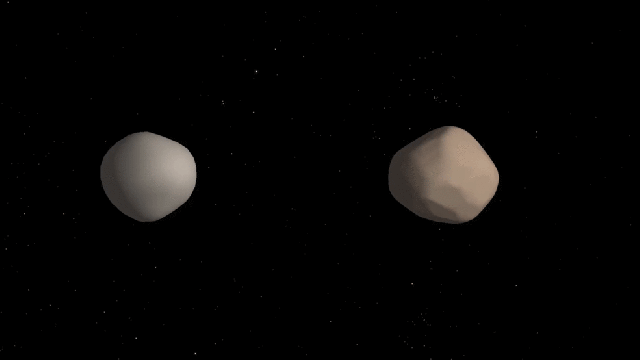When is an asteroid not an asteroid? When it’s a binary pair. Turns out that an asteroid discovered late last year is actually two gravitationally-bound objects in orbit around each other. But this particular duo, dubbed 2017 YE5, belongs to an exceptionally rare class of near-Earth objects.
Near-Earth object 2017 YE5 was first spotted by astronomers at the Oukaïmeden Observatory in Morocco in December of last year, but virtually nothing about it, beyond its presence, was known. In June, the object made the closest approach it will make to Earth for the next 170 years, allowing scientists to take a closer look.
What was initially assessed as a single asteroid turned out to be two objects in orbit around each other: A double asteroid.
Normally we’d say this is no biggie; around 15 per cent of all known asteroids larger than 200m in diameter are binaries. But 2017 YE5 is special because it’s an “equal mass” binary, in which the two objects are roughly the same mass. The vast majority of binaries involve an unequal pair, in which one asteroid is significantly larger than the other.
Astronomers have documented tens of thousands of asteroids in the Solar System, yet this is just the fourth known equal mass binary. The latest observations are now offering the most detailed images ever taken of this exceptionally rare phenomenon.
2017 YE5 came to within six million km of Earth on June 21, which is about 16 times the distance of the Earth to the Moon. Using bistatic radar — a technique in which the transmitter and receiver are placed in separate locations — astronomers at NASA’s Goldstone Solar System Radar (GSSR) in California scanned the object, finding they had a pair of asteroids on their hands, not one.
These observations were later confirmed by astronomers at the Green Bank Observatory (GBO) in West Virginia.
Observations showed that the two asteroids orbit each other once every 20 to 24 hours or so. Also, the asteroids turned out to be larger than expected; these rocks are very dark, about as dark as charcoal, making visual observations difficult. Radar scans revealed their true size; each asteroid measures about 900m in length.
That said, their radar reflectivity patterns were wildly different, which suggests these objects, while similar in size and mass, feature different densities and/or compositions near the surface. A duo, yes, but identical twins, not so much.
As noted, binary asteroids are a relatively common feature of the Solar System. Interestingly, we sometimes see their signature on Earth in the form of “doublet” impact craters, in which the binary pair managed to stay together when entering our planet’s atmosphere and hitting the surface. It’s estimated that around three per cent of all impact craters on Earth are these doublets.
Unfortunately, it also means that, if we ever detect an asteroid on an incoming trajectory, there’s about a 15 per cent chance that it’ll have a partner.
[NASA]
